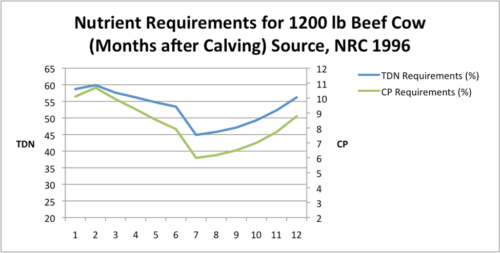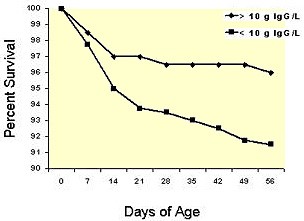Feeding Cattle during Calving Time in the Midwest
Posted: February 25, 2021 | Written By: Heidi Doering-Resch, M.S. - Form-A-Feed

Calving time brings forth a lot of anticipation. Anticipating a new calf crop, a renew of faith in new life, and anticipation of some headaches as well. While we all cannot wait to be on the other side of calving season and see the joys of our hard work; we can help ourselves through this period by understanding how to ease the workload of unthrifty calves through understanding late term nutritional demands on the cow.
Minerals are not a one size fits most. I should repeat that line. Calving and lactation put different demands on our cow herd due to both physiological changes and demands on the cow, but also due to changes in types of feed we are providing them. There are many things that can impact calf vigor and a lot of that is mineral and energy dependent.
A cow’s nutritional demands start to increase the last 60 days prior to calving (Figure 1) with energy demands outdoing protein demands in the last trimester. Having the appropriate amount of Total Digestible Nutrients (TDN) during the last 30 to 60 days on feed will help both the cow prepare for the labors of birth, as well as the calf to grow in utero at the appropriate pace. Alongside the importance of energy, is supplying the right amount of vitamins and minerals to support rapid fetal growth. Without this, calves tend to be born less vigorous or with limited suckling response.
Figure 1. Nutrient requirements by month for protein and energy in a 1,200 lb. mature cow

Looking a little closer at her vitamin/mineral needs, we can see that supplementing different levels of vitamins and trace minerals is critical when fed with dry-harvested hay or crop sources; common to our midwestern diets. Preceding lactation and demands of fetal growth, levels of calcium, magnesium, phosphorus, and potassium needs will also increase. Vitamin A, D, and E increase due to both stress and reduced levels of those nutrients delivered in harvested feedstuffs.
For healthy, productive calves, the importance of colostrum intake within a few hours, if not minutes of birth is key to their longevity in the replacement herd, or their performance in the feedlot (See Figure 2). Calves born to un-supplemented cows have shown to have higher death loss, lower breed backs in the herd, and lower performance in the feedlot. The quality of colostrum is dependent on dam health, her nutritional status, and her ability to pass these antibodies, through colostrum, to her newborn calf. If she is in good condition, she will produce more colostrum and higher concentrations of antibodies to pass to her calf.
Figure 2. Survival Rate vs. days alive when sufficient or insufficient colostrum intake is received.
National Dairy Heifer Replacement Project, USDA:APHIS:VS
When looking at the right late gestation and calving period mineral lines, be sure to have your nutritionist help you decide which mineral is best for your operation. Loose minerals containing Rumensin® are a great way to capitalize on feed utilization, help pay for your mineral line and keep coccidiosis at bay but must be fed through a TMR.
Providing lic tubs while on winter calving ranges helps provide a palatable vitamin and trace mineral supplement without worrying about loose mineral hardening up due to winter elements. Be sure they are complete mineral supplements however as there are products on the market that only contain a small percentage of the animals daily needs to reduce cost of product.
Lastly, when figuring your herds vitamin and trace mineral needs, be sure to price products on a cost per head per day. Intakes of certain minerals differ to meet the nutritional requirements of that animal and how they are formulated by different companies. Just because a low-cost mineral is low cost per ton, or tub, does not mean, accounting for correct intake, that it is cheaper per head per day. Always ask what the price per head is.
Enjoy calving season; it is one of the best times to watch the progress in your operation’s genetics. The innocence of new calves always brings a smile to one’s face. Healthy calves and a new year are always something to celebrate.
